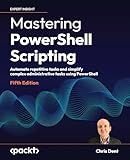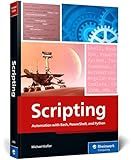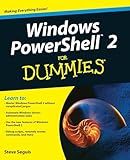Best PowerShell Guides to Buy in December 2025

PowerShell for Sysadmins: Workflow Automation Made Easy
- MASTER WORKFLOW AUTOMATION FOR EFFICIENT SYSTEM MANAGEMENT.
- USER-FRIENDLY GUIDE TAILORED FOR SYSADMINS OF ALL LEVELS.
- PRACTICAL TIPS AND EXAMPLES TO BOOST PRODUCTIVITY EFFORTLESSLY.



Learn PowerShell in a Month of Lunches, Fourth Edition: Covers Windows, Linux, and macOS



Mastering PowerShell Scripting: Automate repetitive tasks and simplify complex administrative tasks using PowerShell



PowerShell Cookbook: Your Complete Guide to Scripting the Ubiquitous Object-Based Shell



Powershell for Beginners A Step-by-Step Guide to Learning Scripting, Cmdlets: Learn PowerShell Basics, Automate IT Tasks, and Boost Productivity with Clear Examples and Practical Exercises



PowerShell Pocket Reference: Portable Help for PowerShell Scripters



PowerShell Automation and Scripting for Cybersecurity: Hacking and defense for red and blue teamers



Scripting: Automation with Bash, PowerShell, and Python—Automate Everyday IT Tasks from Backups to Web Scraping in Just a Few Lines of Code (Rheinwerk Computing)



Windows PowerShell 2 For Dummies


To get the content of XML files using a foreach loop in PowerShell, you can first use the Get-Content cmdlet to read the contents of the XML file into a variable. Then, you can use the [xml] type accelerator to cast the contents of the file as XML. Finally, you can iterate through the XML nodes using a foreach loop to access the specific elements and attributes of the XML file.
How to retrieve specific XML attributes using a foreach loop in PowerShell?
To retrieve specific XML attributes using a foreach loop in PowerShell, you can follow these steps:
- Load the XML file into a variable:
$xml = [xml](Get-Content "path\to\your\file.xml")
- Use the SelectNodes method to select the elements that contain the attributes you want to retrieve, and then loop through them using a foreach loop:
foreach ($element in $xml.SelectNodes("//element")) { $attributeValue = $element.attributeName Write-Output $attributeValue }
Replace path\to\your\file.xml with the actual path to your XML file, "//element" with the XPath expression to select the elements that contain the attributes you want to retrieve, attributeName with the name of the attribute you want to retrieve, and Write-Output with whatever action you want to perform with the attribute value.
By following these steps, you can retrieve specific XML attributes using a foreach loop in PowerShell.
What is a foreach loop in PowerShell?
A foreach loop in PowerShell is used to iterate through a collection of items such as an array or a list. It executes a block of code for each item in the collection, allowing you to perform a specific operation on each item.
The syntax of a foreach loop in PowerShell is as follows:
foreach ($item in $collection) { # Code block to be executed for each item }
In this syntax:
- $item is a variable that represents each item in the collection
- $collection is the collection of items you want to iterate through
- The code block inside the curly braces {} is the operation you want to perform on each item
For example, if you have an array of numbers and you want to print each number using a foreach loop, you can do the following:
$numbers = 1, 2, 3 foreach ($number in $numbers) { Write-Host $number }
This will output: 1 2 3
What is the advantage of using XPath queries for XML manipulation in PowerShell?
One advantage of using XPath queries for XML manipulation in PowerShell is that it allows for more precise and specific querying of XML data. XPath queries provide a way to navigate and select elements and attributes within an XML document based on their structure and relationships. This can be especially useful when working with complex XML documents that contain nested elements or multiple levels of hierarchy.
Additionally, XPath queries provide a standardized and widely-used syntax for selecting XML data, making it easier to share and reuse queries across different scripting languages and tools. By using XPath queries in PowerShell, developers can benefit from the flexibility and power of XPath while leveraging the capabilities of PowerShell for data manipulation and processing.
How to filter XML data using the Select-Xml cmdlet in PowerShell?
You can filter XML data using the Select-Xml cmdlet in PowerShell by providing an XPath expression as the filter criteria. Here's how you can do it:
- Use the Select-Xml cmdlet to load an XML file and store the XML content in a variable:
$xml = Select-Xml -Path "path\to\your\XML\file.xml"
- Use the Select-Xml cmdlet again, this time with the -XPath parameter to filter the XML data based on an XPath expression. For example, if you want to select all elements with the tag name "book" from the XML file, you can use the following command:
$filteredData = $xml | Select-Xml -XPath "//book"
- You can then access the filtered data using the Select-Xml output object:
$filteredData.Node # This will display the filtered XML elements
By providing different XPath expressions, you can filter the XML data based on various criteria such as tags, attributes, values, etc. This allows you to extract specific information from the XML file that meets your requirements.
